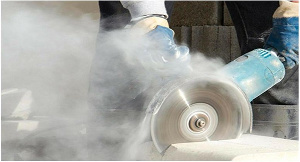It is the desire of every young person to find work or trade, however, there are hazards in every job with corresponding risks; and we are exposed to different levels and combinations of hazards depending on our workplace.
One major workplace hazard is silica – inhalation of its dust leads to diseases such as lung cancer, silicosis, chronic obstructive pulmonary disease (COPD), kidney disease, and autoimmune disease. It is common in mining, construction, engineered stone, quarrying, and landscaping industries.
The size of particles produced from these dusty processes is important and it is the small particle size that is particularly dangerous. They are respirable and are so fine that they are almost invisible. They settle deep in the lungs, and in the alveoli and cause irritation to the lungs.
When the body attempts to heal, it causes scarred tissue to form (fibrosis), replacing healthy tissue. This causes increased mucous production, and shortness of breath and can lead to lung cancer and silicosis.
Silica is found in some stones, rocks, clay, and gravel. Quartz is the most common form of silica and can be found in the following products:
1. Bricks
2. Tiles
3. Concrete, and
4. Some plastics materials
When these materials are worked on or disturbed, silica is released as fine dust known as respirable crystalline silica or silica dust.
Silicosis results in permanent damage to the lung and is a progressive, debilitating, and sometimes fatal disease.
In their Occupational lung disease in Australia report (2006-2019), Safe Work Australia indicated that silicosis cases have emerged particularly in engineered stone workers but the evidence on the prevalence or incidence was still unknown and being actively investigated.
Silicosis can develop or progress even after workplace exposures have stopped.
Symptoms of silicosis may include:
1. cough
2. fatigue
3. shortness of breath
4. chest pain
There is no cure for silicosis
Workers exposed to silica and those who have silicosis are also at risk of tuberculosis (TB), a contagious and potentially life-threatening infection.
Chronic silicosis typically occurs after 10 or more years of exposure to respirable crystalline silica (RCS).
The New South Wales Dust Disease Annual Report 2020-2021 reported that more than 77% of workers diagnosed with silicosis were classified as having ‘chronic’ silicosis. However, the disease can occur much more quickly after heavy exposure (accelerated silicosis).
The Safe Work Australia report also stated that data from health screening programs at the time of the study had so far identified 446 individuals with lung abnormalities from three states in Australia and many of these cases are the accelerated form of silicosis, some are Progressive Massive fibrosis (PMF).
A study commissioned by the Australian Council of Trade Unions and published in April 2022 titled “The future burden of lung cancer and silicosis from occupational silica exposure in Australia: A preliminary study” suggests over 100,000 Australian workers will suffer from silicosis due to current workplace conditions.
You may be exposed to silica dust if your work involves:
1. breaking, crushing, grinding, or milling materials containing silica dust
2. sandblasting or casting
3. paving, surfacing, or cement finishing
4. bricklaying
5. demolishing work
6. road construction
7. stone masonry or cutting
8. mineral ore – treating process
9. manufacture of glass, ceramics, brick, concrete, tile, granite, and others 10. minerals, artificial stone, metals, or machinery
11. hydraulic fracturing in the oil and gas industry
12. tunneling
Effective Controls
It is imperative that Ghana has a harmonized health and safety law that can be enforced to protect workers. That aside:
employers must prioritize the health and safety of their workers and others at their workplace artisans must be trained or educated to prioritize their health and safety as well as those they train employers must make it their duty to control the risks associated with work at their sites workers or employees must take reasonable care of their own health and safety; must not negatively affect the health and safety of other people, and follow any reasonable instruction and health and safety policies at their workplace.
In prioritizing the health and safety of workers, employers should eliminate or reduce exposure to hazards by following a risk management process known as the Hierarchy of Risk Control. If suitable control measures are not in place, anyone working around silica dust or welding fumes has an increased risk of developing lung cancer and other illnesses listed above.
Note: It is important that workers should always be involved in this process.
https://cdn.ghanaweb.com/imagelib/pics/857/85786987.jpg
Figure 1: Hierarchy of risk control
Source: Department of Health, Victoria State, Australia
1. For people who work in the engineered stone, brick manufacturing, etc. were cutting, grinding, sanding, or polishing occurs (generally the industries that produce silica dust), engineering controls such as using tools equipped with water suppression or exhaust ventilation systems built into the tools, must be implemented.
2. Road construction, some mining, and demolition activities must have a dust suppression regime where water is sprayed regularly to reduce the amount of dust that escapes into the atmosphere.
3. For general construction, always consider ways of reducing the amount of dust the work might make. Use different materials, less powerful tools, or other work methods. For example, one can use:
a. The right size of building materials so less cutting or preparation is needed
b. Silica-free abrasive to reduce the risks when blasting
c. Wet cutting
d. A different method of work altogether – e.g., a direct fastening system.
Respiratory protection equipment (RPE) is the last line of defense to prevent dust exposure as shown in the image above (figure 1). Key points to a successful RPE program are:
1. Appointing a program administrator
2. Selecting the appropriate RPE based on e.g., the toxicity of the contaminant,
3. exposure standard, and physical suitability for the task
4. Medical screening of users of RPE, where appropriate
5. Training
6. Fit testing
7. Issuing of RPE
8. Maintenance of RPE
9. Disposal of RPE
10. Record keeping
11. Program evaluation
The time to act in protecting Ghana’s workforce is now. Be part of the advocacy for better health and safety at our workplaces.
Columnist: David Tettey Noi
 Home Of Ghana News Ghana News, Entertainment And More
Home Of Ghana News Ghana News, Entertainment And More





